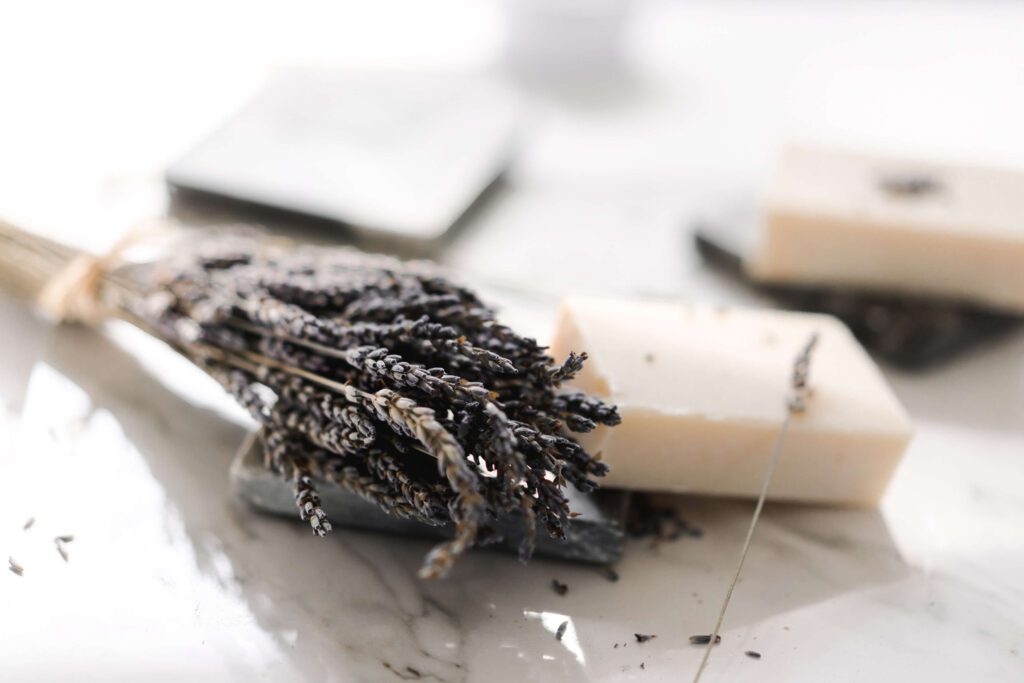
When to Harvest Lavender Seeds? We explore the world of lavender by first understanding how harvesting lavender seeds at the correct time is crucial for gardeners looking to propagate their lavender plants. But also important for when you want to make your own herbal remedies with lavender. Ensuring when it is best to harvest lavender will ensure optimal growth in terms of quality and vitality of your lavender plant.
The process requires precision, as the timing of for lavender harvest can significantly impact the quality and viability of the seeds. Typically, the best time to collect lavender seeds for best results is late summer, when the flowers have matured and the seed heads turn brown and dry lavender. This period indicates that the seeds have fully developed and are ready for collection.
To ensure successful germination, it’s essential to monitor the development of your lavender blooms closely. As the flowering season concludes, keep an eye out for the seed heads beginning to split. This is nature’s signal that the seeds are ripe for harvesting. By choosing the optimal harvest time, you maximise the potential for robust seedlings in your next planting season, ensuring your garden continues to flourish with the fragrant flower of lavender – your herb garden will be thriving with the most fragrant flowers!
Key Takeaways
- Harvest lavender seeds late summer when seed heads are brown and dry.
- Watch for seed heads splitting, indicating ripeness for harvest.
- Proper timing ensures high viability for future germination.
WHAT ARE WE TALKING ABOUT TODAY?
- Understanding Lavender Seed Basics
- Preparation for Harvesting
- Harvesting Process
- Post-Harvest Seed Care
- Frequently Asked Questions
Understanding Lavender Seed Basics
Before starting your lavender journey, you need to be well-versed in the types of lavender you can grow, the unique characteristics of their seeds, and the ideal growing conditions that ensure a healthy and successful harvest.


Lavender Varieties
Among the various types of lavender, English lavender (Lavandula angustifolia) is renowned for its high-quality essential lavender oils and is commonly cultivated. On the other hand, French lavender (Lavandula stoechas) is better suited for warmer and arid climates and has a different oil profile which some find equally alluring. Choosing between the two depends greatly on your climate and intended use.
RELATED: 27 Useful Ways To Use Lavender Leaves
Seed Characteristics
Your lavender’s future starts with its seeds, which tend to be small and require careful handling. Germination can be a slow process, so patience is vital. The seeds of English lavender, in particular, might take up to three weeks to sprout, necessitating a controlled environment.
- Size: Very small, numerous per capsule
- Colour: Pale to dark brown
- Texture: Smooth, round to oval shape
Optimal Conditions for Seed Growth
Best way to grow lavender from seed demands specific conditions to flourish:
- Soil: You’ll want to avoid poor soil. To do this, ensure well-draining and light, with a neutral to slightly alkaline pH level; this encourages strong root development without waterlogging.
- Soil Temperature: Warm temperature is ideal. Consistently between 18-24°C (64-75°F) to trigger germination and promote healthy growth.
- Light: Lavender seeds need ample light; ensure they are not buried too deep in the soil to access full sun.
- Water: Regular but moderate watering to keep the soil slightly moist, avoiding oversaturation.
It’s important to sustain these conditions especially through the critical early stages of growth. Once established, lavender is drought-tolerant and thrives with minimal fuss, provided it’s in a sunny spot with good airflow.
Preparation for Harvesting


To successfully harvest lavender seeds, you’ll need to time your efforts correctly and prepare specific tools, whilst also considering various pre-harvest factors to ensure the quality and viability of your seeds – it’s a simple, easy task so don’t sweat!
Best Time to Harvest
The ideal time to harvest your lavender seedlings in autumn, just before the seed pods fully mature and burst open. This is typically when the flowers have faded and the seed pods have turned a brown colour but are not yet releasing their seeds. For cultivars like Munstead, the precise timing may vary, so observe the seeds closely as autumn progresses.
Tools Needed
Prepare the following tools for harvesting:
- Scissors or secateurs: To snip the flower stalks.
- A paper bag: For collecting and drying the seeds.
Pre-Harvest Considerations
Before harvesting, select a dry day to prevent moisture from affecting the quality of the seeds. Harvest in the morning after the dew has evaporated but before the midday sun, which ensures seeds are dry and helps retain their viability. Check the seed pods; they’re ready if they’re slightly open but not fully, revealing the mature, dark seeds inside. If harvesting in spring, remember that flowers may yield fewer seeds than an autumn harvest.
Harvesting Process
When harvesting lavender seeds, timing and technique are crucial for ensuring the viability of your seeds for future planting. Below you will find detailed steps to identify and collect mature seeds from your lavender plants.
Identifying Mature Seed Heads
To identify when lavender seed heads are mature, look for browned or greyish tones replacing the vibrant purple flowers. The seed heads will appear dry and are often easier to crumble between your fingers. Lavender seeds themselves are small, shiny, and dark, usually black or brown. Mature seeds indicate that it’s the right time to start collecting for next season’s planting. When you observe the presence of true leaves on a lavender plant, it signalises a mature plant which often corresponds with seed maturity.
Collecting Seeds
Once the seed heads are mature, begin the collection process by cutting the lavender stems with a pair of clean, sharp scissors or secateurs. Cut approximately 2cm below the seed heads to include a small stem portion. Lay out the lavender stems in a warm, dry place to further aid drying, if needed. After drying, gently rub the seed heads between your palms over a clean, flat surface or bowl to dislodge the seeds. Use a fine sieve to separate the seeds from the chaff. Store your collected seeds in a labelled, airtight container and keep them in a cool, dry place until you are ready to sow them, which usually takes place in the spring. Remember, the sooner you start lavender seeds after harvest, the better, as they lose viability with time.
Post-Harvest Seed Care
After harvesting your lavender seeds, it’s crucial to handle them properly to maintain their viability. Proper drying, storage, and understanding of sowing techniques are key.
Drying and Storing Seeds
Once your lavender seeds are harvested, they need to be dried to prevent mould and degradation. Spread the seeds in a single layer on a paper or a mesh screen in a dry, well-ventilated area out of direct sunlight. It can take several days to a few weeks for the seeds to dry completely. After the seeds are dried, store them in paper envelopes or glass jars. Keeping them in a cool, dark place will help maintain their viability until you’re ready to propagate.
Tip: Label your containers with the seed type and date of harvest to keep track of your seed inventory.
Sowing and Propagation Tips
When you’re ready to propagate, it’s important to remember that lavender has a low germination rate; therefore, patience and careful attention to detail are essential. Sow the seeds on top of a well-drained soil mix, barely covering them with a light sprinkle of soil, as they need light to germinate. The ideal planting depth is just about 1-2mm. Ensure your planting containers provide adequate drainage to prevent waterlogging, which can cause seedlings to rot. Once sown, keep the soil moist but not overly watered. Lavender typically germinates best at temperatures between 18°C to 21°C.
Tip: Due to the low germination rate, consider planting more seeds than the number of plants you desire, or try propagating lavender from cuttings to increase your chances of successful plant growth.
Frequently Asked Questions
When harvesting lavender seeds, timing and technique are crucial to ensure high-quality seeds for the next planting season and to ensure successful healthy lavender plants.
What is the best season to collect seeds from lavender grown in containers?
You should aim to collect seeds from your container-grown lavender after flowering, typically in late summer. This period allows the seeds to mature adequately before collection.
What are the indicators that lavender seeds are ready to be harvested in Australia?
In Australia, lavender seeds are ready to harvest when the seed heads turn brown on the plant. The flowers will appear dry and are easily crumbled between your fingers.
How can one successfully propagate lavender using dried stems?
To propagate lavender using dried lavender stems, take semi-hardwood cuttings from the current year’s growth. This can be done in autumn. Strip the leaves from the bottom half and plant them in a well-draining potting mix.
What are the steps involved in gathering lavender blooms for use in sachets?
To gather lavender blooms for sachets, cut the stems when the lowest flowers on the spike just begin to open. Dry them in a cool, dark place, then gently remove the flowers from the stems.
How can one extract seeds from a lavender plant for future growth?
Extract seeds from a lavender plant by collecting the dry seed heads, then separating the seeds from the husks. A fine sieve can help with removing the chaff.
What measures should be taken with lavender seeds post-harvest?
After harvesting your lavender seeds, store them in a cool, dry place. A moisture-proof container is ideal to prevent mould and maintain viability until sowing.



Comments +